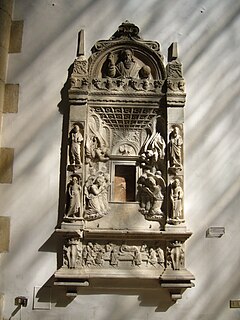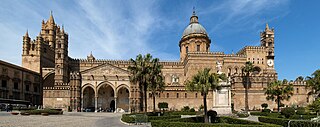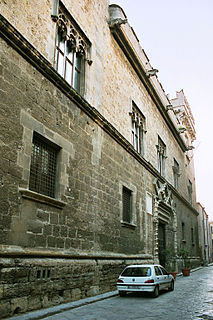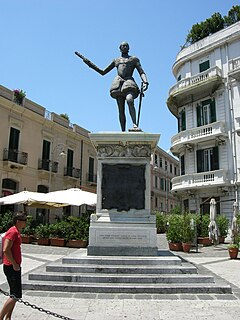
Messina is a harbour city and the capital of the Italian Metropolitan City of Messina. It is the third largest city on the island of Sicily, and the 13th largest city in Italy, with a population of more than 231,000 inhabitants in the city proper and about 650,000 in the Metropolitan City. It is located near the northeast corner of Sicily, at the Strait of Messina and it is an important access terminal to Calabria region, Villa San Giovanni, Reggio Calabria on the mainland. According to Eurostat the FUA of the metropolitan area of Messina has, in 2014, 277,584 inhabitants.

Sicilian Baroque is the distinctive form of Baroque architecture which evolved on the island of Sicily, off the southern coast of Italy, in the 17th and 18th centuries, when it was part of the Spanish Empire. The style is recognisable not only by its typical Baroque curves and flourishes, but also by its grinning masks and putti and a particular flamboyance that has given Sicily a unique architectural identity.

Antonello Gagini (1478–1536) was an Italian sculptor of the Renaissance, mainly active in Sicily and Calabria.

Tommaso Maria Napoli was an Italian architect, Dominican Order monk, engineer and mathematician.

Domenico Gagini was a Swiss-Italian sculptor who was active in Northern as well as Southern Italy.

Monreale Cathedral is a Roman Catholic church in Monreale, Metropolitan City of Palermo, Sicily, southern Italy. One of the greatest existent examples of Norman architecture, it was begun in 1174 by William II of Sicily. In 1182 the church, dedicated to the Nativity of the Virgin Mary, was, by a bull of Pope Lucius III, elevated to the rank of a metropolitan cathedral as the seat of the diocese of Monreale, which was elevated to the Archdiocese of Monreale in 1183. Since 2015 it has been part of the Arab-Norman Palermo and the Cathedral Churches of Cefalù and Monreale UNESCO World Heritage site.

Castelbuono is a town and comune in the Metropolitan City of Palermo, Sicily.

Nicosia is a Town and comune of the province of Enna in Sicily, southern Italy. It is located at 720 m above the sea level, on a rocky massive culminating in four imposing hills. The origin of Nicosia is uncertain. Nicosia and Troina are the northernmost towns in the province of Enna. The vicinity was traditionally made up of salt mines and arable lands.

Palermo Cathedral is the cathedral church of the Roman Catholic Archdiocese of Palermo, located in Palermo, Sicily, southern Italy. It is dedicated to the Assumption of the Virgin Mary. As an architectural complex, it is characterized by the presence of different styles, due to a long history of additions, alterations and restorations, the last of which occurred in the 18th century.

Palazzo Abatellis is a palazzo in Palermo, Sicily, southern Italy, located in the Kalsa quarter. It is home to the Galleria Regionale della Sicilia, the Gallery of Art for the Sicilian region.

Natale Masuccio, also known as Mesuccio or Tomasucci, was an Italian architect and Jesuit. He is regarded as one of the most important architects in Sicily during the transition between Mannerism and Baroque.

San Francesco d'Assisi is a 16th-century-style church dedicated to Saint Francis of Assisi, located in Alcamo, province of Trapani, Sicily, southern Italy.

Nicosia Cathedral is the cathedral of the Roman Catholic Diocese of Nicosia, Sicily, and is located in Nicosia, Sicily, Italy. It is dedicated to Saint Nicholas of Bari. The Cathedral preserves a precious and unique wooden roof of 1300.

The Church of Saint Francis of Assisi is a Gothic-style, Roman Catholic church of Palermo. It is located near a major and ancient street of the city, via Cassaro, in the quarter of the Kalsa, within the historic centre of Palermo. The building represents the main Conventual Franciscan church of Sicily, and has the title of minor basilica.

The Museo Interdisciplinare Regionale (MuMe). or Regional Museum of Messina, is an art museum located on the northern coast of the city of Messina, Sicily, Italy.

The Interdisciplinary Regional Museum of Messina is a museum of painting, sculpture and archaeology in the city of Messina. Until 2017 it was housed in the former Barbera-Mellinghoff silk-mill, a late 19th century building chosen for it after the 1908 Messina earthquake. Since 2017 it has been housed in a nearby complex designed in the 1970s.
The Diocesan Museum of Palermo is a museum of religious art in Palermo on Sicily, housed in a number of rooms in the Palazzo Arcivescovile opposite Palermo Cathedral.

Andrea Calamech (1524-1589) was an Italian sculptor and architect.

Rinaldo Bonanno (1545-1600) was an Italian sculptor. Born in Raccuja, he is notable for his work in Sicily in the second half of the 16th century. His whole oeuvre was heavily influenced by the Tuscan tradition and the style of Michelangelo, but combined these with elements of the late Gothic style and influences from the work of Gagini. Despite his 'archaizing' traits, he is considered one of the best sculptors active in that era in Sicily.
Gioacchino Di Marzo was an Italian art historian, librarian and Jesuit. He was librarian to the Comunale di Palermo as well as a historiographer and one of the founders of modern Sicilian art history.





























